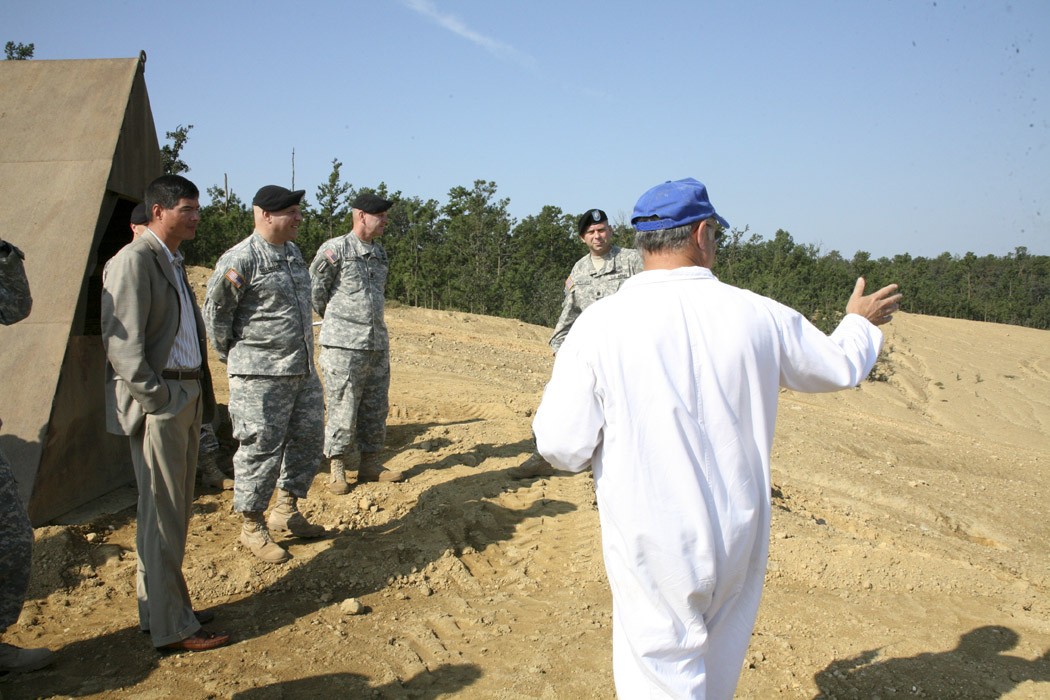ANNISTON ARMY DEPOT, Ala.-History was made at Anniston Defense Munitions Center on Sept. 8 with the destruction of the last batch of M47 DRAGON missiles in the Army's inventory. Army leaders and other special guests were here to witness this event.
The M47 Dragon missile was first fielded in January 1975 and then issued to U.S. Soldiers stationed in Europe. Preparations for the DRAGON manufacturing started in September 1959 when the Army Ordnance and Missile Command saw the need for a medium range heavy assault weapon. This idea evolved over the next several years with the U.S. Army Ballistic Missile Agency recommending the development of a heavy anti-tank weapon.
After almost a decade of planning and testing by the Army and McDonnell-Douglas, the DRAGON name was born in 1967. The DRAGON missiles saw their final combat action during Operations Desert Shield/Desert Storm. In August 2006, the DRAGON was officially classified as "obsolete" by the Department of the Army.
Brig. Gen. Genaro Dellarocco, Army Program Executive Officer-Missiles and Space, traveled from Redstone Arsenal in Huntsville to witness the destruction of the DRAGONs in what he called "an informative and history making event."
"It is not too often that you get to close the chapter on a weapons system such as the DRAGON," said Dellarocco, who was stationed at Anniston Army Depot from 1987 to 1990 in a different capacity. "It is a bittersweet feeling to see the end of a weapons system that was so vital to our warfighters, but the DRAGON is being replaced by a more accurate and more lethal weapon system."
The DRAGON has been replaced on the battle field by the FGM-148 Javelin missile, which is stored and maintained at Anniston Defense Munitions Center.
ADMC was directed in 2006 to destroy the Army's stockpile of DRAGON missiles, according to the Aviation and Missile Command, Operational Integration Directorate, Missile Demilitarization Program Office. The demilitarization and disposal plan called for a total of 3,500 missiles per year being destroyed from 2006 through 2008. The destruction of the missiles was ramped up during 2009 to 5,433.
All of the hard work and preparations paid off when the final 24 missiles were destroyed Sept. 8 through an Open Burn/Open Detonation (OB/OD) method at the ADMC demilitarization grounds, or 'demil pit,' as it's called.
"Anytime we finish a job, we're glad to have completed it safely," said Chris Rogers, engineering equipment operator at the demil pit. "I'm glad we're not going to see any more DRAGONs because they pack a lot of power and create a bigger hole."
As always, safety was the primary concern of leaders at ADMC and Armywide. "Safety was extremely important during this task and it was performed exceptionally well by the true professionals here at Anniston Defense Munitions Center," said Deputy to the Commander of Joint Munitions Command Jyuji Hewitt. "It is fitting that ADMC was given this historic mission, given their history of safety, professionalism and always working effectively and efficiently."
"It is a dual-edged sword; on one hand we are losing the DRAGON, but on the other we are stepping into the future with more reliable and lethal weapons systems," said ADMC Commander Lt. Col. Duncan Macmullen. "Hats are off to the demil crew for a safe and effective mission completion."
Macmullen presented Dellarocco, Hewitt and other distinguished guests with plaques containing data plates from some of the destroyed missiles to commemorate this momentous occasion.
After destruction of the last DRAGONs, the guests toured a few other locations inside the ADMC area of operations, to include the TOW Missile Recycling Center and a planned storage site for the Terminal High Altitude Area Defense (THAAD) missile, which is scheduled to be stored at ADMC in 2010.
The group then visited the Hellfire Missile Depot, a government-owned/contractor-operated missile maintenance facility operating closely with ADMC's missile distribution capability.






Social Sharing